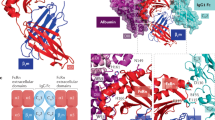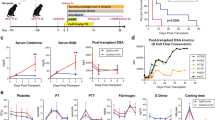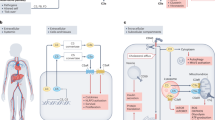Abstract
Systemic tolerance can be induced by the introduction of antigen into an immune-privileged site. Here we investigated the role of complement in the induction of tolerance after intraocular injection. We found that the development of antigen-specific tolerance is dependent on a complement activation product. The ligation of the complement C3 activation product iC3b to complement receptor type 3 (the iC3b receptor) on antigen-presenting cells resulted in the sequential production of transforming growth factor-β2 and interleukin-10, which is essential for the induction of tolerance. These observations may extend to the development of both neonatal tolerance and other forms of acquired tolerance.
This is a preview of subscription content, access via your institution
Access options
Subscribe to this journal
Receive 12 print issues and online access
$209.00 per year
only $17.42 per issue
Buy this article
- Purchase on Springer Link
- Instant access to full article PDF
Prices may be subject to local taxes which are calculated during checkout





Similar content being viewed by others
References
Frank, M.M. & Fries, L.F. The role of complement in inflammation and phagocytosis. Immunol. Today 12, 322–326 (1991).
Thomlinson, S. Complement defense mechanisms. Curr. Opin. Immunol. 5, 83–89 (1993).
Carroll, M.C. The role of complement and complement receptors in induction and regulation of immunity. Annu. Rev. Immunol. 16, 545–568 (1998).
Nielsen, C.H., Fischer, E.M. & Leslie, R.G.Q. The role of complement in the acquired immune response. Immunology 100, 4–12 (2000).
Arvieux, J., Yssel, H. & Colomb, M.G. Antigen-bound C3b and C4b enhance antigen-presenting cell function in activation of human T-cell clones. Immunology 65, 229–235 (1988).
Dempsey, P.W., Allison, M.E.D., Akkaraju, S., Goodnow, C.C. & Fearon, D.T. C3d of complement as a molecular adjuvant: Bridging innate and acquired immunity. Science 271, 348–350 (1996).
Jacquier-Sarlin, M.R., Gabert, F.M., Villiers, M.-B. & Colomb, M.G. Modulation of antigen processing and presentation by covalently linked complement C3b fragment. Immunology 84, 164–170 (1995).
Streilein, J.W. Immunologic privilege of the eye. Springer Semin. Immunopathol. 21, 95–111 (1999).
Kaplan, H.J. & Streilein, J.W. Immune response to immunization via the anterior chamber of the eye. I. F1 lymphocyte-induced immune deviation. J. Immunol. 118, 809–814 (1977).
Kaplan, H.J. & Streilein, J.W. Immune response to immunization via the anterior chamber of the eye. II. F1 lymphocyte-induced immune deviation. J. Immunol. 120, 689–693 (1978).
Streilein, J.W. & Niederkorn, J.Y. Induction of anterior chamber-associated immune deviation requires an intact, functional spleen. J. Exp. Med. 153, 1058–1067 (1981).
Wilbanks, G.A. & Streilein, J.W. Macrophages capable of inducing anterior chamber associated immune deviation demonstrate spleen-seeking migratory properties. Reg. Immunol. 4, 130–137 (1992).
Wilbanks, G.A. & Streilein J.W. Characterization of suppressor cells in anterior chamber-associated immune deviation (ACAID) induced by soluble antigen. Evidence of two functionally and phenotypically distinct T-suppressor cell populations. Immunology 71, 383–389 (1990).
Sonoda, K.-H., Exley, M., Snapper, S., Balk, S.P. & Stein-Streilein, J. CD1-reactive natural killer T cells are required for development of systemic tolerance through an immune-privileged site. J. Exp. Med. 190, 1215–1225 (1999).
Wilbanks, G.A., Mammolenti, M. & Streilein, J.W. Studies on the induction of anterior chamber-associated immune deviation (ACAID). III. Induction of ACAID depends upon intraocular transforming growth factor-β. Eur. J. Immunol. 22, 165–173 (1992).
D'orazio, T.J. & Niederkorn, J.Y. Splenic B cells are required for tolerogenic antigen presentation in the induction of anterior chamber-associated immune deviation (ACAID). Immunology 95, 47–55 (1998).
Streilein, J.W. Immune privilege as the result of local tissue barriers and immunosuppressive microenvironments. Curr. Opin. Immunol. 5, 428–432 (1993).
Hara, Y., Okamoto, S., Rouse, B. & Streilein, J.W. Evidence that peritoneal exudates cells cultured with eye-derived fluids are the proximate antigen-presenting cells in immune deviation of the ocular type. J. Immunol. 151, 5162–5170 (1993).
Sohn, J.-H., Kaplan, H.J., Suk, H.-J., Bora, P.S. & Bora, N.S. Chronic low level complement activation within the eye is controlled by intraocular complement regulatory proteins. Invest. Ophthalmol. Vis. Sci. 41, 3492–3502 (2000).
Kabat, E.A. & Mayer, M.M. in Experimental Immunohistochemistry (ed. Thomas, C.C.) 133–239 (Springfield, IL, 1961).
Diamond, M.S., Garcia-Aguilar, J., Bickford, J.K., Corbi, A.L. & Springer, T.A. The I domain is a major recognition site on the leukocyte integrin Mac-1 (CD11b/CD18) for four distinct adhesion ligands. J. Cell Biol. 120, 1031–1043 (1993).
Foris, G., Fust, G. & Medgyesi, G.A. The effect of oligopeptides on the C3b receptor-mediated functions of rat macrophages. Immunol. Lett. 6, 7–11 (1983).
Simpson, A.E.C.M., Tomkins, P.T. & Cooper, K.L. An investigation of the temporal induction of cytokine mRNAs in LPS-challenged thioglycollate-elicited murine peritoneal macrophages using the reverse transcription polymerase chain reaction. Inflamm. Res. 46, 65–71 (1997).
Fritzinger, D.C., Bredehorst, R. & Vogel, C.W. Molecular cloning and derived primary structure of cobra venom factor. Proc. Natl. Acad. Sci. USA 91, 12775–12779 (1994).
Wessels, M.R. et al. Studies of group B streptococcal infection in mice deficient in complement component C3 or C4 demonstrate an essential role for complement in both innate and acquired immunity. Proc. Natl. Acad. Sci. USA 92, 11490–11494 (1995).
Robinson, A.P., White, T.M. & Mason, D.W. Macrophage heterogeneity in the rat as delineated by two monoclonal antibodies MRC OX-41 and MRC OX-42, the latter recognizing complement receptor type 3. Immunology 57, 239–247 (1986).
Ross, G.D. & Lambris, J.D. Identification of a C3bi-specific membrane complement receptor that is expressed on lymphocytes, monocytes, neutrophils, and erythrocytes. J. Exp. Med. 155, 96–110 (1982).
Ross, G.D. & Vetvicka, V. CR3 (CD11b, CD18): A phagocyte and NK cell membrane receptor with multiple ligand specificities and functions. Clin. Exp. Immunol. 92, 181–184 (1993).
Taylor, A.W., Streilein, J.W. & Cousins, S.W. Identification of α-melanocyte stimulating hormone as a potential immunosuppressive factor in aqueous humor. Curr. Eye Res. 11, 1199–1206 (1992).
Taylor, A.W., Streilein, J.W. & Cousins, S.W. Immunoreactive vasoactive intestinal peptide contributes to the immunosuppressive activity of normal aqueous humor. J. Immunol. 153, 1080–1086 (1994).
Cousins, S.W., McCabe, M.M., Danielpour, D. & Streilein, J.W. Identification of transforming growth factor-β as an immunosuppressive factor in aqueous humor. Invest. Ophthalmol. Vis. Sci. 32, 2201–2211 (1991).
Streilein, J.W. Unraveling immune privilege. Science 270, 1158–1159 (1995).
Griffith, T.S., Brunner, T., Fletcher, S.M., Green, D.R. & Ferguson, T.A. Fas ligand-induced apoptosis as a mechanism of immune privilege. Science 270, 1189–1192 (1995).
Hammerberg, C., Duraiswamy, N. & Cooper, K.D. Reversal of immunosuppression inducible through ultraviolet-exposed skin by in vivo anti-CD11b treatment. J. Immunol. 157, 5254–5262 (1996).
Hammerberg, C., Katiyar, S.K., Carroll, M.C. & Cooper, K.D. Activated complement component 3 (C3) is required for ultraviolet induction of immunosuppression and antigenic tolerance. J. Exp. Med. 187, 1133–1138 (1998).
Tsuji, R.F. et al. Requried early complement activation in contact sensitivity with generation of local C5-dependent chemotactic activity, and late T cell interferon γ: A possible initiating role of B cells. J. Exp. Med. 186, 1015–1026 (1997).
D'orazio, T.J. & Niederkorn, J.Y. A novel role for TGF-β and IL-10 in the induction of immune privilege. J. Immunol. 160, 2089–2098 (1998).
Karp, C.L. et al. Mechanism of suppression of cell-mediated immunity by measles virus. Science 273, 228–231 (1996).
Yoshida, Y. et al. Monocyte induction of IL-10 and down-regulation of IL-12 by iC3b deposited in ultraviolet-exposed human skin. J. Immunol. 161, 5873–5979 (1998).
Kosiewicz, M., Alard, P. & Streilein, J.W. Alteration in cytokine production following intraocular injection of soluble protein antigen: impairment in IFN-γ and induction of TGF-β and IL-4 production. J. Immunol. 161, 5382–5390 (1998).
Miller, A., Lider, O., Roberts, A.B., Sporn, M.B. & Weiner, H.L. Suppressor T cells generated by oral tolerization to myelin basic protein suppress both in vitro and in vivo immune responses by the release of transforming growth factor β after antigen-specific triggering. Proc. Natl. Acad. Sci. USA 89, 421–425 (1992).
Shankland, S.J. et al. Differential expression of transforming growth factor-β isoforms and receptors in experimental membranous nephropathy. Kidney Int. 50, 116–124 (1996).
Kalli, K.R., Ahearn, J.M. & Fearon, D.T. Interaction of iC3b with recombinant isotypic and chimeric forms of CR2. J. Immunol. 147, 590–594 (1991).
Ross, G.D. Analysis of the different types of leukocyte membrane complement receptors and their interaction with the complement system. J. Immunol. Methods 37, 197–211 (1980).
McQuillen, D.P. et al. Complement processing and immunoglobulin binding to Neisseria gonorrhoeae determined in vitro simulates in vivo effects. J. Infect. Dis. 179, 124–135 (1995).
Acknowledgements
We thank J.P. Atkinson for critical review of the data and Y. Wang for help with RT–PCR analysis. This work was supported in part by EY09730, EY10543 and EY 13335, Commonwealth of Kentucky Research Challenge Trust Fund and Research to Prevent Blindness Inc., NY.
Author information
Authors and Affiliations
Corresponding author
Ethics declarations
Competing interests
The authors declare no competing financial interests.
Rights and permissions
About this article
Cite this article
Sohn, JH., Bora, P., Suk, HJ. et al. Tolerance is dependent on complement C3 fragment iC3b binding to antigen-presenting cells. Nat Med 9, 206–212 (2003). https://doi.org/10.1038/nm814
Received:
Accepted:
Published:
Issue Date:
DOI: https://doi.org/10.1038/nm814
This article is cited by
-
The HSP GRP94 interacts with macrophage intracellular complement C3 and impacts M2 profile during ER stress
Cell Death & Disease (2021)
-
An intact complement system dampens cornea inflammation during acute primary HSV-1 infection
Scientific Reports (2021)
-
New insights into the immune functions of complement
Nature Reviews Immunology (2019)
-
The eye as a complement dysregulation hotspot
Seminars in Immunopathology (2018)
-
Involvement of B cells in non‐infectious uveitis
Clinical & Translational Immunology (2016)



